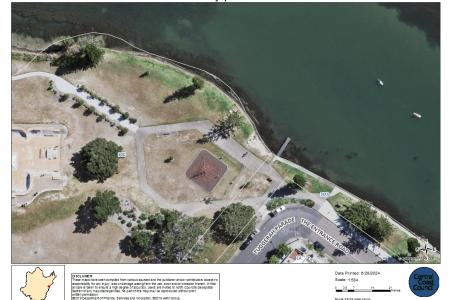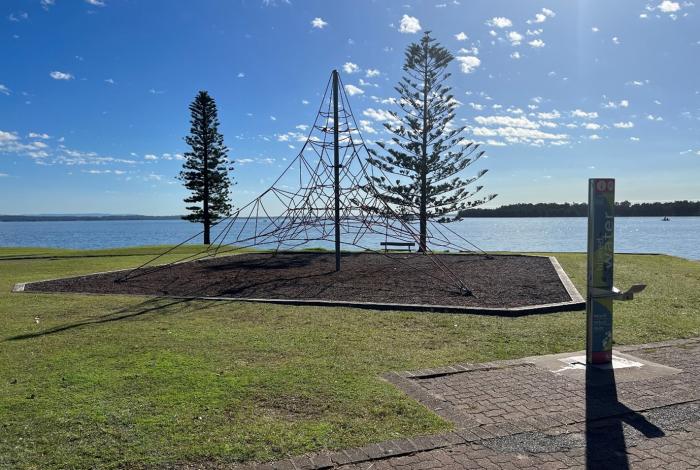We are preparing an upgrade to the current playspaces at Picnic Point Reserve to provide The Entrance with a district level playspace that captures the needs of our community.
The existing local playspace near the amenities within the reserve is no longer serviceable and will be consolidated into a single, larger play area incorporating the existing rope climbing unit to the north of the reserve. The new playspace will be designed and constructed in accordance with the Central Coast Council’s Playspace Strategy and to meet current Australian Standards.
We are asking the community to complete a short survey for us to better understand the types of users of the park as well as the equipment and infrastructure you would like to see. To provide you with some types of the infrastructure that could be included in the park, here are some example suggestions:
- A new accessible path connecting the playspace with the existing skatepark
- Shade structures over the play areas
- Concrete or sandstone edging for the playspace surrounds
- Additional garbage bin slabs
It will also have ‘Full Accessibility Play’ for a minimum of 40% of equipment. The types of equipment may include:
- Combination swing set for junior and standard abilities
- Separate large nest swing
- Play units with slides aimed at 5yrs – 10yrs
- A low level play unit with slide aimed at 0yrs – 4yrs
- Imaginative play equipment: boat and pelican themed spring/spin toys
Have your say
We recognise our community is diverse and is made up many varied and wonderful individuals from various paths of life. To acknowledge and embrace that uniqueness, we are driven to provide a playspace upgrade that is representative of this. As a result, we encourage you to give your feedback to enable us to identify our users and plan for the future.
You were invited to submit your feedback between Friday 21 June and Monday 22 July 2024.
Your attention is drawn to the provisions of the Government Information (Public Access) Act 2009 which allows for possible access to certain public and personal documentation. View our privacy statement.
Basic Documents
Segmented Documents
Timeline
Who's listening
FAQs
Council’s Engagement Framework, initially adopted in 2017, built staff engagement skills and fostered a culture or engagement throughout our organisation. We have now integrated the principles of this framework into a unified strategy, creating a single, cohesive document and point of reference for our staff and community.
The purpose of the Strategy is to establish principles and guidelines for how Council engages with the community and to also inform the community about their opportunities and rights to be involved in Council’s decision-making process.
Having an engagement strategy is legislatively required for councils in NSW. The draft Strategy is guided by NSW Government legislation which requires each NSW council to develop and implement a four-year engagement strategy under the Local Government Act 1993.
Now more than ever, our community is seeking better access to information and greater transparency in decision-making. To meet these needs, we are updating our understanding of how various groups across our diverse population prefer to engage with Council matters.
We aim to continue running activities that effectively reach all individuals impacted by our projects and plans. This involves offering accessible opportunities for everyone, particularly those who are hard-to-reach, such as busy families, youth, disadvantaged groups, and those with limited access to technology. The Strategy includes methods for achieving this, along with Council’s guiding principles for engagement.
Community engagement refers to how we engage with our community. The process commences with providing information to our customers and community, with the aim to seek and incorporate informed feedback to ensure we reach the best possible outcomes that benefit all stakeholders.
Education is key to effective community engagement and decision-making. It also allows our community to make informed choices that maximise the services we deliver.
Council’s previous Engagement Framework was developed using community feedback, best practices from other councils and levels of government and insights from the International Association of Public Participation (IAP2).
In 2017 and 2018, we held five ward-based community workshops, conducted surveys and gathered input from the Community Strategic Plan engagement. This extensive feedback provided a clear understanding of community preferences for engagement and consultation. After reviewing the feedback from the public exhibition, we finalised the strategy and presented a report for Council's consideration at the 26 March 2018 Council Meeting. Council received the report and implemented improvements to the Engagement Framework.
The Framework defines Council’s approach to engagement with the aim to ensure that we do what we say we will do and that we apply engagement in a consistent way. The Framework provides direction to effectively engage and communicate with our community and customers and provides guidance on when and how to undertake engagement activities and what steps and processes should be considered.
Since its adoption, the Framework has been supported by an Internal Engagement Improvement Plan to drive improvement and capability. The Improvement Plan has been continuously reviewed in 2019, 2021 and 2022 to adjust to changing community and organisational needs. The Improvement Plan and our community’s ongoing feedback have driven improvements to the Framework, resulting in the development of the draft Community Engagement Strategy.
The methods used for external consultation and feedback have included:
• 2018: Five workshops and an online survey; results reported to Council in March 2018
• 2020: Customer satisfaction survey
• Ongoing: Evaluations from the “Let’s Talk” initiative
• 2024: Community wellbeing survey, including questions on engagement
• July/August 2024: Public exhibition, market research, and targeted stakeholder
engagement.
Council follows engagement principles as outlined in the Strategy through the activities presented in the table below:
| Engagement Activity | Comments |
| Your Voice - Our Coast (online) |
This online platform represents best practice community engagement. The platform is used for complex consultation projects, surveys, polls, discussions, including a planned engagement calendar and exhibition items and acts as a one-stop shop for engagement in the online environment. This platform also provides the results of engagement activities and information back to the community on decisions made. This site also has links to Council’s social media platforms. |
| Social Pinpoint |
Interactive map that allows comments and issues. We use social pinpoint so that participants online can identify the location of either the issue or where they live (or both) and leave a comment. This is particularly affective for masterplan engagement or complex planning or infrastructure projects. Analysis of this feedback is cross referenced with the face-to-face feedback and other activities for a rigorous consideration of trends, challenges and ideas. |
| Community pop-ups, drop-ins and workshops | This is one of the most popular community engagement initiatives with communities with the aim of having informal conversations with Council staff in local areas. The purpose of these activities is to understand what is important for ratepayers, residents, businesses, visitors and stakeholders. |
| Place-based Engagement |
By understanding what residents need at a neighbourhood level, Council can collectively facilitate effective and robust community engagement across the entire Local Government Area (LGA). This program is building up capacity within Council to understand the issues, identity and character of an area as well as better coordinate service delivery and planning. In future the focus it is intended that comments from each local place should be analysed and themed so that trends and issues across the wider LGA can also be identified. |
| Projects, Partnerships and Program |
Our tailored community engagement activities are developed and implemented to engage with external and internal stakeholders across a range of Council plans, projects and programs, to discuss changes to their local area, to foster long term relationships and community partnerships. Engagement methods are chosen from the spectrum and range from online and face to face conversations, surveys, focus groups, workshops, world cafes and activity planning. Where possible we continue to make it more convenient for people to attend and/or provide feedback. |
| Community Education |
Community education activities such as workshops, tours and information sessions are developed and implemented to provide people with the opportunity to learn and embrace attitudinal/behavioural change, to achieve shared understanding between Council and the community and to implement awareness campaigns. Examples include estuary education, waste education, library programs, road safety and environmental education. |
| Contacting Council |
Council's Customer Experience program improves contact with Council and provides regular updates and feedback to customers. Customers can currently use the following channels: • In person at service centres and libraries • Online Customer Service Centre • Telephone • Web feedback • Social Media • By post • Submissions for items on public exhibition • View livestream Council meetings • Speaking at a Council meeting • Other online and mobile-enabled self-service portals |
All relevant feedback on the document will be considered by the project team before the final document is developed. Council staff will then prepare a report on the outcome of the public exhibition process for Council's consideration.
As detailed in the Draft Operational Plan 2024-25, there is $376,000 planned to be allocated for the design of construction of this playspace.
Yes, the principle of providing inclusive and accessible playspaces will continue in line with the NSW Government's ‘Everyone can Play’ guidelines and Central Coast Council's Disability Inclusion Action Plan to meet the needs of our diverse range of users.
Inclusive playspaces provide for all abilities, not just access. Accessible playspace design mainly addresses the movement needs of those with disabilities. Council staff undergo continued development in the area of Inclusive & Accessible playspaces and are committed to making places more inclusive for everyone.
Yes – the alternative will be the playspace to the south/west near the amenities building, which will be decommissioned post completion of the district playspace. The Entrance foreshore also has facilities for use during the construction phase.
As per the Draft Operational Plan 2024-25, this project is expected to be completed by the end of the financial year 2024/2025. This page will house project updates on the stages achieved throughout.
We recognise our community is diverse and is made up of individuals from various paths of life. To acknowledge and embrace that uniquity, we are driven to provide a playspace upgrade that is representative of this. As a result, we encourage you to submit your feedback to enable us to identify our users and plan for the future.
You are invited to submit your feedback between Wednesday 19 June and Tuesday 16 July 2024 by:

